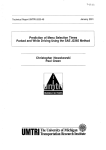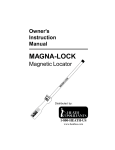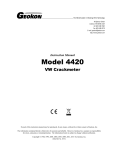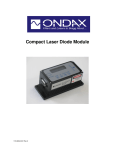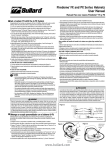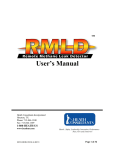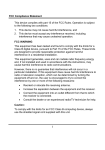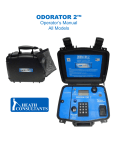Download User Manual PDF - Heath Consultants
Transcript
SURE-LOCK Utility Pro User Manual ® Proprietary Notice The contents of this manual are proprietary to Heath Consultants Incorporated. Reproduction of this manual, in whole or in part, is prohibited without the express written consent of Heath Consultants Incorporated. Heath Consultants Incorporated operates under a continual product improvement program and reserves the right to make improvements and/or changes without This manual supersedes all previous manuals for the Heath Sure-Lock Utility Pro. HPN 1016002, Revision D ©COPYRIGHT 2012, Heath Consultants Incorporated SURE-LOCK® Utility Pro User Manual Heath Consultants Incorporated Houston, TX 713-844-1300 Fax: 713-844-1309 1-800-HEATH-US www.heathus.com Heath....Safety, Leadership, Innovation, Performance Then, Now and Tomorrow FUNCTION The Sure-Lock® Utility Pro is a state-of-the-art, 81KHz cable and pipe locator locate underground utilities. The instrument’s dual microcomputers, fixed frequency, automatic loading feature, and outstanding transmitter power output make it especially effective for tracing a variety of conductors and for those situations where a radio frequency locator increases the likelihood of success. Virtually all buried utilities capable of signal conduction can be more accurately and conveniently located with the Sure-Lock Utility Pro. It also has a power-sensing power lines and cathodic protection systems. This manual will provide the operator with information concerning the features, operation, and care of this instrument. continuous, trouble-free operation for many years. This manual will provide the operator with information concerning the features, operation, and care of this instrument. The Sure-Lock has been designed to 1 TABLE OF CONTENTS Function ........................................................................... 1 CHAPTER I - GENERAL DESCRIPTION Description of System Components ....................................................... Transmitter ....................................................................... Receiver ............................................................................... Cable/Grounding Kit ........................................................ Instruction Manual .................................................. Carrying Case ............................................................ Coupler Clamp (Optional) ...................................................... 4 4 4 4 4 4 5 Sure-Lock Frequency Selection Guide ........................................... 5 Figure 1-1 (System Components) ....................................................... 6 Sure-Lock Transmitter .............................................................. 7 Specifications ................................................................... 7 Controls ...................................................................... 8 Figure 1-2 (Transmitter) ......................................................................... 9 Figure 1-3 (Transmitter Side PanelOutput Connector) ......................... 9 Sure-Lock Receiver ................................................................ 10 Specifications .................................................................... 10 Figure 1-4 (Receiver) ............................................................... 11 Controls .......................................................................... 12 Additional Connector ............................................................... 14 Figure 1-5 (Receiver - Additional Connector) ....................................... 14 CHAPTER II - GENERAL OPERATING PROCEDURES Operating Procedures ................................................................. 15 Transmitter .................................................................... 15 Transmitter - Inductive Mode .................................................... 16 One Operator Sweep - Inductive Mode ..................................... 16 Figure 2-1 (Transmitter Alignment) ............................................... 17 Figure 2-2 (Transmitter Alignment) .................................................. 18 Figure 2-3 (Transmitter Alignment) ................................................. 19 Two-Operator Sweep – Inductive Mode ...................................... 19 Figure 2-4 (Two-Operator Sweep) ....................................................... 20 Figure 2-4 (Two-Operator Sweep) ....................................................... 20 Conductive (Direct Connect) Mode ............................................... 21 Figure 2-6 (Correct and Incorrect Grounding Application) ................ 23 Using the Coupler Clamp ..................................................... 23 Figure 2-7 (Coupler Clamp Connection) ........................................ 25 Figure 2-8 (Coupler Clamp Connection) ........................................ 26 Figure 2-9 (Coupler Clamp Connection) ........................................ 26 2 Using the Receiver ......................................................................... 26 Figure 2-10 ............................................................................... 28 Conductor Depth Procedure ...................................................... 29 CHAPTER III - MAINTENANCE Battery Charging And Replacement Instructions .................................. Transmitter ........................................................................ Receiver ........................................................................ Routine Maintenance of the Sure-Lock .................................................. Optional Accessories ....................................................................... Warranty and Warranty Repairs ........................................................... Repair Authorization ............................................................... Customer Assistance and Service Locations ....................................... 3 31 31 31 32 33 34 35 36 CHAPTER I GENERAL DESCRIPTION DESCRIPTION OF SYSTEM COMPONENTS (See Figure 1-1) Transmitter self-monitoring features as well as replaceable batteries for high portability. It is housed in a durable ABS plastic case. The wide body design provides stability is constructed of a corrosion-resistant aluminum alloy. Receiver The receiver also combines numerous automatic performance and self monitoring features, all microcomputer based. These features include automatic gain control, continuous estimated and calculated depth display, operator guidance, sealed membrane switch controls for ease of use, and frequency selection. Its housing is ergonomically balanced and constructed of ABS plastic for strength and durability. Six easily accessible, long-lasting AA batteries power the receiver. The receiver is fully sealed against rain and dust. Cable/Grounding Kit The cable/grounding kit consists of the following: 1. “L” Shaped grounding spike 2. Aluminum grounding plate 3. Conductive cable assembly 4. Bridging Cable (With Clamp only) Instruction Manual This manual provides instrument reference, maintenance, and warranty information. Carrying Case The carrying case is constructed of tough, high molecular weight polyethylene. The molded and padded interior provides protection from moisture, shock, and vibration. **NOTE** THE SURE-LOCK SHOULD BE KEPT IN ITS CARRYING CASE WHEN NOT IN USE. 4 Coupler Clamp (Optional) Model 58 HPN 56212309 An alternate direct method of energizing the conductor is with a coupler clamp. This device can be used with the transmitter to apply the signal to the conductor of conductors when they are selectively energized at the transmitter location. When it can be used, the coupler clamp is a very accurate means for tracing and identifying conductors because of its ability to keep signals away from interfering conductors. The coupler clamp is a unique tool that generally enhances the separation of the signal compared to conventional methods of energizing the trace conductor. The coupler clamp is also the most effective method of isolating a conductor from interfering conductors in the area of the search. It CANNOT be used on all tracing applications. Since there is no grounding device in use with the coupler clamp, the signal must be able to travel in both directions on the conductor. If the trace point of attachment, the coupler clamp may not function. This “break” in the continuity of the conductor creates an opening in the conductor loop that will not allow an audio frequency signal to propagate. Frequency (kHz) Transmitter Clamps(s) 81 D-Cells 58 The Utility-Pro utilizes 50/60 hertz power sense in the receiver and is NOT capable of having its transmitter output directly connected to live AC power lines. The clamps shown are optional. SURE-LOCK Frequency Selection Guide 81 K Model 58 Versatile conductive or inductive locating - All utilities - Coated pipe - Bare steel 50-60 Power mode used for electric – Primary and Secondary 5 D A B C F E G Figure 1-1 (System Components) A. Transmitter E. Grounding Plate B. Receiver F. Coupler Clamp 4” ID (Optional) C. Case G. Grounding Spike D. Manual 6 SURE-LOCK TRANSMITTER (Figure 1-2) 1. OUTPUT FREQUENCIES: Active, 81 kHz. 2. OUTPUT JACKS: Single frequency available on an individual output jack. 3. OUTPUT MODE: Conductive and/or inductive with automatic load matching. DOES NOT allow direct connection to live AC power lines. 4. OUTPUT POWER: Variable to 0.6 watts with automatic load matching. Loads from 5 ohms to 10 K ohms. 5. LCD: Indication of output power, load matching and battery level. 6. OPERATOR INTERFACE: Power and power test switches. 7. BATTERY TYPE: 6 Alkaline D-Cells. 8. BATTERY LIFE: 110-190 hours. 9. BATTERY STATUS: Shown on the LED via the LED’s brightness. 10. OPTIONS: Coupler clamp. 11. TEMPERATURE RANGE (operational): -25 degrees Fahrenheit to 150 degrees Fahrenheit (-32 degrees Celsius to 65 degrees Celsius). 12. DIMENSIONS: 8.1” L x 5.1” W x 5.4” D (20.7 cm L x 13 cm W x 13.7 cm D), typical. 13. WEIGHT: 4.0 lbs. (1.8 kg), typical. 14. CONSTRUCTION: Weather resistant ABS plastic housing designed for NEMA 3S and IP 54. The housing is also shock and vibration resistant. The Sure-Lock is shipped in a black, hard shell, high molecular weight polyethylene carrying case. 7 Controls The Sure-Lock low frequency transmitters have several controls and indicators with which the operator must become familiar (Figure 1-2). A. LED INDICATOR. Indicates the transmitter’s output level and battery charge level via the LED’s relative brightness. B. POWER TEST SWITCH. Pressing and holding this switch down will allow the use of the LED Indicator for testing the transmitter. C. POWER ON-OFF SWITCH. Used to turn the transmitter power on and off. D. DIRECT ACCESSORY (81K OUTPUT) JACK. Used for connecting the 81K output to the target conductor. E. CONDUCTOR DIRECTION ARROW. The transmitter, when used inductively, must be placed with the conductor direction arrow directly over and parallel to the target conductor. 8 A B E D C Figure 1-2 (Transmitter) A. LED Indicator D. Direct Accessory Jack B. Power Test Switch E. Conductor Direction Arrow C. Power ON/OFF Switch A Figure 1-3 (Transmitter Side Panel Output Connector) A. Direct Accessory Jack (81 KHz) Output Color Coded White and Blue 9 WARNING! SAFETY FIRST! Check for and turn off all power sources before connecting the transmitter directly to otherwise power carrying cables. Direct connection must NOT be to live 50/60 hertz power sources up to 240 VAC!! The power must be OFF!! Be certain the transmitter POWER is off before handling the clips on the conductive assembly. The transmitter can deliver over 100 volts of signal which is capable of producing electrical shock if not carefully handled. SURE-LOCK RECEIVER (Figure 1-4) 1. 2. 3. 4. 5. 6. 7. 8. 9. 10. 11. 12. 13. 14. 15. 16. 17. 18. ACTIVE FREQUENCIES: 81 kHz with Left-Right and depth displayed. PASSIVE FREQUENCIES: 50-60 hertz without Left-Right depth. DYNAMIC RANGE: 124 dB, typical. DEPTH RANGE: Range to 20’ (240” or 610 cm) continuously displayed (estimated depth). Metric units (cm) selectable per order. Automated “calculated depth” function. LEFT-RIGHT GUIDANCE: LCD indicators and audio prompts are present. AUDIO RESPONSE TYPE (Passive): Variable pitch. GAIN ADJUSTMENT: Automatic. LCD: Automatic backlighting. Indication of signal strength, battery level, operating frequency mode, estimated and calculated depth, self-test status, speaker volume, Left-Right arrows and signal LOCK. OPERATOR INTERFACE: Interface accomplished via two sealed overlay membrane switches. BATTERY TYPE: Six alkaline AA cells (NEDA 15A). BATTERY LIFE: 90-120 hours. Automatic shutdown occurs 90 minutes after idle (no switches pressed). BATTERY STATUS: Continuous indication on the display. ACCESS PORT: For coupler clamps. TEMPERATURE RANGE (operational): -25 degrees Fahrenheit to 150 degrees Fahrenheit (-32 degrees Celsius to 65 degrees Celsius). DIMENSIONS: 30 1/2” L x 5 1/2” W x 1 1/4” D (77.5 cm L x 14 cm W x 3.2 cm D), typical. WEIGHT: 5.3 lbs (2.4 kg). CONSTRUCTION: ABS plastic weather resistant housing meets NEMA 3S and IP 54 standards. RUGGEDNESS: Withstands three foot drops to ground (soil). 10 A I B C H D G E F Figure 1-4 (Receiver) A. Signal Power Indicator (SPI) B. Left-Right Indicator C. Battery Status Indicator D. Lock Indicator E. On-Off/Volume Switch F. Bubble Level G. Frequency Select Switch H. Estimated/Calculated Depth Indicator I. Volume Level Indicator 11 Controls The receiver has several unique features, controls, and indicators with which the operator must become familiar (Figure 1-4). 1. DISPLAY: This display provides the operator with information concerning the location and depth of the conductor being traced. A variety of information is displayed. a. Signal Power Indicator (SPI) - The SPI provides the operator with a dual purpose numerical readout of the relative signal strength of: 1. A normal (active) tracing mode signal using the transmitter. 2. conductor. The transmitter is not used in this mode. The readout will display from 0 - 999. As the operator gets closer to the intended conductor, the numbers increase and as the operator moves further away from the intended conductor, the numbers decrease. **NOTE** THESE SPI NUMBERS ARE RELATIVE AND DO NOT BEAR ANY SIMILARITY TO NUMBER SYSTEMS USED ON OTHER MODELS. FOR EXAMPLE, READINGS OF 164, 285, ETC., REPRESENT SUFFICIENTLY STRONG SIGNALS FOR LEFT-RIGHT AND DEPTH READINGS. b. Left-Right Indicator - The left-right indicator readout is a multi-segment bar graph with directional arrows that indicate the direction to the intended conductor. As the operator approaches the conductor, the multi-segment bar graph will shorten, and, as the operator moves further away from the conductor, the bar graph will lengthen. When the receiver is positioned directly over the intended conductor, the right and left bars and arrow will disappear from the display, but the LOCK indicator will remain on. c. Battery Status Indicator - Continuous readout appears in 20% increments of battery capacity. d. On/Off Volume Switch - This switch has two purposes in the receiver. First, it turns the receiver on. Once on, repeated pressing of this switch will step the speaker to successively higher volumes (3 levels total) and then put the receiver in a power off mode where “OFF” is shown in the display. 12 e. Lock Indicator - The LOCK indicator is a unique feature of SureLock. When the LOCK indicator appears on the display, the receiver is locked to the signal being generated by the transmitter. This indicator assures the operator of adequate signal strength for measurements on the conductor. **NOTE** WHEN THE LOCK INDICATOR BECOMES INTERMITTENT OR DISAPPEARS FROM THE DISPLAY, THE OPERATOR HAS EXCEEDED THE MAXIMUM RANGE OF THE TRANSMITTER SIGNAL. DEPTH WILL NOT BE CALCULATED IF THE LOCK INDICATOR IS NOT STEADILY ILLUMINATED. THE TRANSMITTER SHOULD BE REPOSITIONED OR SET TO HI POWER IN ORDER TO IMPROVE THE SIGNAL STRENGTH. f. Bubble Level - The bubble level is used to manually position the receiver vertically to engage the automatic calculated depth function. The bubble level may also be used in manually cross checking calculated depth, especially uneven surfaces (Hills). g. Frequency Select Switch - The frequency select switch is used to toggle the receiver through its individual frequencies. h. Estimated/Calculated Depth Indicator - The estimated depth indicator provides a continuous reading of estimated depth in inches or centimeters for a quick, real-time reading during locating. Changing the estimated depth readings alert the operator of potential factors which may affect locating accuracy. An automatic calculated depth reading will replace the estimated depth reading when applicable. **NOTE** THE SURE-LOCK IS AVAILABLE WITH THE DEPTH READOUT IN CENTIMETERS. THIS FEATURE IS PRESET AT THE FACTORY. i. Volume Level Indicator - This 3 stage indicator relates to the speaker volume currently selected. Successive presses of the ON-OFF/VOLUME switch toggles through increasing volume, receiver power off, receiver power on and back through the 3 speaker volume levels. j. Speaker (not shown) - The speaker provides two distinctly separate audio tones, which correspond to the bar graph and directional arwhich is lower in pitch, corresponds to the conductor being to the left 13 of the operator. The second one is higher in pitch and corresponds to the conductor being to the right of the operator. When the receiver is positioned directly over the conductor, the speaker will null (produce no sound). Additional Connector A Figure 1-5 (Receiver - Additional Connector) A. Accessory Jack ACCESSORY JACK: The accessory jack is located near the handle and is labeled ACCESS. This jack is utilized to connect to coupler clamps and other accessories. 14 CHAPTER II GENERAL OPERATING PROCEDURES OPERATING PROCEDURES This portion of the manual is broken down into the TRANSMITTER and RECEIVER sections. The Sure-Lock works as an integrated system. In order to understand this system, the operator must understand the importance and proper use of each part of the system. **NOTE** IN THIS MANUAL, THE TERM “CONDUCTOR” REFERS TO ANY METALLIC STRUCTURE TO BE TRACED. THIS MAY INCLUDE ELECTRIC LINES, CABLES, GAS LINES, WATER LINES, TRACER WIRES, ETC. Transmitter The most important element in properly locating a buried underground conductor is to properly energize the conductor. This is the function of the transmitter. Therefore, the operator must understand the function of the transmitter in the system and learn which mode of operation is best for any given locating assignbe traced back to improper use or incorrect positioning of the transmitter. Before using the transmitter in any of the following applications, it is essential complete the expected operation. To test the battery, simply turn the transmitter on, press and hold down the power test switch, and observe the relative brightness of the LED indicator. The LED indicator will dim with low battery levels. There are three modes of operation that can be used to energize conductors with the transmitter. These modes are: 1. 2. 3. Inductive or Indirect Connect Conductive or Direct Connect Coupler Clamp (Model 58) The output jack on the transmitter, the coupler clamp plugs and the conductive attachment plugs are color coded for proper selection and use. The colored mating halves must match. The transmitter “DIRECT ACCESSORY” output is coded both white and blue and should only be used with the conductive attachments which are color coded blue or with the model 58 coupler clamps which are color coded white. 15 Transmitter - Inductive Mode The inductive mode of operation is the easiest and simplest mode of using the transmitter as no direct access to the conductor is needed. However, the operator must thoroughly understand how the transmitter functions in this mode of operation in order to avoid the locating pitfalls that can accompany this mode of operation. There are two ways to energize the conductor using the inductive mode. They are as follows: 1. 2. One Operator Sweep Two Operator Sweep One Operator Sweep - Inductive Mode When using the one operator sweep, the operator must know where the conductor is located at one particular point. This “starting point” may be a valve box, riser, pedestal, repair patch, etc. When a known starting point is determined, the transmitter is turned on and the positioned directly over the top of the conductor to be traced so that the arrow is aligned with the path of the conductor (Figure 2-1). **NOTE** THE STRONGEST SIGNAL TRANSFERS TO THE CONDUCTOR WHEN THE TRANSMITTER IS CENTERED DIRECTLY OVER THE CONDUCTOR WITH THE ARROW ALIGNED PARALLEL TO THE PATH OF THE CONDUCTOR. 16 Figure 2-1 (Transmitter properly aligned with the conductor) One of the pitfalls the operator must recognize is that when the transmitter is functioning in the inductive mode, other conductors in the area may also be energized. When the transmitter is functioning in this application, it is energizing the conductor with an electromagnetic signal. This signal is not only going onto the intended conductor but it is also being radiated onto the other conductors surrounding the transmitter. These other conductors might include overhead power or telephone lines, chain link fences, guard rails, railroad tracks, or other utilities in the area of the transmitter. If the operator suspects there will be interference from other conductors, a direct mode of connection should be used to energize the conductor and to help eliminate these interfering conductors. If signals from another conductor are causing interference during the trace, they will affect the accuracy of the locater. The operator should attempt to connect the transmitter directly to the conductor by means of a direct connect assembly (discussed later) or by means of the coupler clamp. If this is not possible, the transmitter should be positioned as shown as in Figure 2-2. With the transmitter positioned as shown, the target conductor can be energized with minimum signal placed on the interfering conductor. 17 Figure 2-2 (Transmitter positioned on its end directly over the interfering conductor. This position will energize the target conductor and apply minimum signal to the interfering structure) Another common mistake that must be understood and avoided in the indirect mode of operation is AIR COUPLING. As was previously mentioned, the signal is being radiated around the transmitter. When the transmitter and receiver are receiver. This phenomenon can be avoided by maintaining an interval of at least 75 feet (23 m) between the receiver and transmitter at all times. If a trace is required closer than 75 feet and the conductor cannot be energized by direct connect means, the following step should be taken. Set the transmitter on its end, 1 to 2 feet to the side of the conductor (Figure 2-3). By using the transmitter in this position, the receiver can now work in closer proximity to the transmitter. With the transmitter in this position, the operator should maintain a minimum distance of 35 feet (11 m). More discussion concerning elimination and determination of air coupling will occur in the receiver portion of this manual. Once the conductor has been energized by the proper placement of the transmitter, the operator should walk the recommended distance away from the transmitter with the receiver. The receiver should then be used to sweep the area while watching the display and listening to the distinct tone changes as receiver senses the conductor. 18 Conductor Figure 2-3 (Transmitter positioned on its end for closer tracing applications. This set-up will reduce the air coupling distance) Two Operator Sweep - Inductive Mode Another method of locating a conductor inductively is by means of the two operator sweep. This method is generally used when no starting or ending point is known for a given conductor. To perform the two operator sweep, turn on the transmitter and receiver. One operator carries the transmitter while the other operator carries the receiver. Both operators line up so that both the receiver and transmitter are aligned as in selves to avoid air coupling. The operators slowly move across the search area and in the direction of the suspect conductor. The operator with the transmitter must make sure to hold the instrument so that the ARROW on the transmitter is aligned parallel to the suspected path of the conductor. Once the line is located (Figure 2-5), the transmitter can then be placed over the conductor and the conductor traced by using the same procedures as described for the one operator sweep. It must be noted that once a conductor is located, it is up to the operator to verify that this is the intended conductor. This may be accomplished by tracing the conductor to a junction point on the conductor such as a valve, junction box, pedestal, etc. 19 Figure 2-4 (Operators properly positioned to begin the two operator sweep) Figure 2-5 (Two operator sweep. The operators have energized and located the conductor) 20 Conductive (Direct Connect) Mode Whenever possible, the conductive method is preferred for energizing the conductor. By using a direct hookup, the operator can help eliminate locating mistakes often associated with the inductive method, i.e., energizing other structures and air coupling. By using a direct energizing method, the operator helps isolate the target connector from other conductors in the area and will generally receive a better signal with which to conduct the locate. The Sure-Lock comes with a direct connection cable/grounding kit consisting of grounding cables, grounding plate, grounding spike, and bridging cable. WARNING! SAFETY FIRST! Check for and turn off all power source(s) before connecting the transmitter directly to power carrying cables. Direct connection must NOT be to live 50/60 hertz power sources up to 240 VAC. The power must be OFF!! Be certain the transmitter POWER is off before handling the clips on the conductive assembly. The Sure-Lock transmitter can deliver 100 volts of signal which is capable of producing electrical shock if not carefully handled. To energize the conductor with the direct connect mode, the operator should The RED cable should then be connected to the conductor to be traced. A good connection to the conductors is essential for a clear, strong signal. Any rust, corrosion, or paint should be removed in order to obtain a good metal to metal contact. The BLACK cable is then extended as far away from the conductor as the cables will allow. It is then attached to a suitable grounding source such as the if soil penetration is not permitted, such as with concrete. If the plate is laid obtain a good ground. A GOOD GROUND IS ESSENTIAL! It is generally advisable to ground perpendicular to the structure being traced. The operator must be aware at all times of where the grounding cables run and what is used as a ground. The cables are carrying the full signal current, and, if the operator 21 should ground over the top of or close to another conductor, the other conductor may be energize and jeopardize the locate (Figure 2-6). If a foreign structure such as a chain link fence is being used for ground, that structure will also be energized and could confuse the operator. Always be aware of the importance and function of the ground in the DIRECT CONNECT application. **NOTE** REMEMBER THAT THE SIGNAL ON THE GROUND WIRE IS AS STRONG AS THE SIGNAL ON THE CONDUCTOR. Once the conductor is energized using the direct connect method, the operator may use the receiver to search for the signal using the same techniques described in the one operator sweep. Since there is now a direct connection to the conductor, the inductive antenna on the transmitter is not active. The operator can now work closer to the transmitter and not be affected by air coupling. It should be understood that the operator will start picking up signals near the grounding cables as they are radiating the same signal carried by the target conductor. (Correct - Grounding Application) (Incorrect - Grounding Application) Figure 2-6 22 Using the Coupler Clamp Model 58 HPN 56212309 (optional) Another direct means of energizing the conductor is with a coupler clamp. This device can be used with the transmitter to apply the signal to the conductor, or conductors when they are selectively energized at the transmitter location. When it can be used, the coupler clamp is a very accurate means for tracing and identi1. INSTRUCTIONS FOR SINGLE COUPLER CLAMP USE: Before using the coupler clamp, refer to the coupler clamp applications section which starts on the next page. a. b. c. d. 2. Plug the coupler clamp into the appropriate output jack on the transmitter. Turn on the transmitter. Attach the coupler clamp around the conductor to be traced making sure the “jaws” of the clamp are fully closed. The contact points of the coupler clamp must not touch the conductor. Turn on the receiver and begin the search allowing the receiver to guide you to the conductor per instructions under Using the Sure-Lock Receiver in Chapter II, page 26. USING DUAL COUPLER CLAMPS: This method of operation is especially useful for energizing and identifying a conductor running with other conductors, i.e., manhole-to-manhole traces, manhole-to-cable vault, etc. To utilize this method, two coupler clamps are necessary and direct access is required at both the transmitter and receiver locations. c. d. transmitter and turn the transmitter on. Plug the second coupler clamp into the “ACCESS” jack located on the front of the receiver and turn the receiver on. Now begin to search for the energized conductor by attaching the coupler clamp around the conductor(s) in question and observe the SPI readings on the display. The conductor showing the highest SPI will be the conductor being energized by the transmitter at the other end of the locate run. Typical application instructions and diagrams for using the coupler clamp model 58: 23 The coupler clamp is a unique tool that generally enhances the separation of the signal as compared to conventional methods of energizing the trace conductor. The coupler clamp is also an effective method of isolating a conductor from interfering conductors in the area of search. It CANNOT be used on all tracing applications. Since there is no grounding device in use with the coupler clamp, the signal must be able to travel in both directions on the conductor. If the trace point of attachment, the coupler clamp may not function. This “break” in the continuity of the conductor creates an opening in the conductor loop that will not allow the signal to propagate. In such situations, this conductor loop must be closed. The coupler clamp comes equipped with a bridging cable which can be used for this purpose. This cable is used to “bridge” the break in continuity. The cable can be attached to bridge an tected gas line with the insulator at the meter set (Figure 2-7). Caution must be taken when using the bridging cable in such situations and it may be used only after obtaining permission. It MUST be removed after the locate is completed. In the event that the point of attachment is at the termination or dead end of a conductor, the termination point must be grounded away from the directional run of the conductor. Once this is accomplished, the signal is allowed to travel and the coupler clamp will now function (Figure 2-8). Both ends of the conductor may need to be connected to earth ground. The coupler clamp is an ideal device for tracing cables as a direct connect hookup is often not possible without having to enter pedestals or junction boxes and without making a metal-to-metal contact. The jaws on the coupler clamp must be closed and completely encircle the conductor in order to function properly (Figure 2-9). 24 (Correct - Bridging cable attached around the insulator bridges the break in the conductor loop) Figure 2-7 25 (Correct - Grounding attachment allows signal (Correct. - The coupler clamp jaws are closed around the conductor. The conductor is energized) (Incorrect - Terminated end (open circuit). The (Incorrect - The coupler clamp jaws are clamped to the conductor. The conductor is not energized) Figure 2-8 Figure 2-9 Using the Receiver A correct understanding of the transmitter’s use is important to assure proper signals at the receiver’s location. As a highly developed computerized instrument, the Sure-Lock is capable of providing remarkable accuracy in a wide 1. ONCE THE CONDUCTOR IS PROPERLY ENERGIZED: a. Turn the receiver on and select the appropriate frequency matching that on the transmitter. c. operational time. The battery test indication will read in 20% increments of available voltage in the batteries. The operator should slowly sweep the receiver as it searches for the conductor. The operator will notice the following visual and audio indications on the display and from the built-in speaker: LOCK indicator will appear on the display. This assures that the 26 functions. ii. LEFT-RIGHT INDICATOR: A multi-segmented bar graph will appear on the display with the directional arrows to guide the operator to the conductor. In conjunction with the directional arrows, special tones will come from the speaker. One tone, which is lower in pitch, corresponds to the conductor being to the left of the operator. Another tone is higher in pitch and corresponds to the conductor being to the right of the operator. When the receiver is positioned directly over the conductor, the speaker will null (produce no sound). The VOLUME switch may be used to adjust the loudness as desired. iii. SIGNAL POWER INDICATOR: SPI numbers will appear on the display panel. These numbers will range from 0 - 999. As the operator nears the conductor, the numbers will increase and as the operator moves away from the conductor, the numbers will decrease. The numbers are the highest when the operator is nearest to the conductor and when the receiver is lined up with it (Figure 2-10). iv. ESTIMATED/CALCULATED DEPTH: The estimated depth indicator provides a continuous reading of estimated depth for a quick, real-time reading during locating. Unexpected estimated depth readings alert the operator of potential factors which may affect locating accuracy. An automatic calculated depth reading supersedes the estimated depth reading. Refer to page 29 for Calculated Conductor Depth Procedure. 27 Left Lock Figure 2-10 28 Right When the operator has pinpointed the exact location of the conductor (using the above indicators) and the receiver is positioned directly above the conductor, the following will occur: a. b. c. d. e. The LOCK indicator will remain active on the LCD display. The left-right arrows and segmented bar graph will disappear from the display. The audio left-right tones will null (produce no sound). The SPI will show the highest relative number on the display. The estimated depth will be displayed. Each of these indications gives the operator valuable information about the conductor being traced. It is an indication that the conductor has NOT been pinpointed if ALL the above do not occur. Conductor Depth Procedure Once the conductor has been pinpointed using the audio and visual indicators as previously described, the operator may then perform a calculated depth indication reading. The operator should follow these procedures to obtain a calculated depth reading: 1. 2. 3. 4. 5. While maintaining a vertical position, rest the tip of the probe on the ground directly over the conductor with the receiver blade perpendicular to the conductor. Hold the receiver in a vertical position with the bubble in the bubble level centered. It must not angle away from, toward, or to the left or right of the operator. onds to obtain an automatic calculated depth calculation. The operator should then see the CLC followed by a number appearing on the display. This number will remain displayed for several seconds and will indicate the depth in inches (or centimeters, optional) to the CENTER of the conductor. The receiver features automatic return to search mode and estimated depth. It is good practice to take at least 2-3 depth readings as a cross check. To repeat a depth reading, maintain a vertical position. If a depth indication does not appear on the display or there is not logical sequence to the numbers, it usually means the following: a. b. c. d. “Ghost Signal” (jittery L/R and SPIs). Air-coupling to the transmitter. Interference from other conductors. Exceeding the 240” (610 cm) depth limit. 29 **NOTE** THIS CONDITION MAY BE EVALUATED USING TWO METHODS. ONE METHOD IS BY PIVOTING THE RECEIVER 180 DEGREES WHICH MAY PRODUCE DEPTH READING WHICH DIFFER BY 10%. SUCH DIFFERENCES UP TO 15-20% MAY BE AVERAGED AND WHICH CAN BE THE RESULT OF A TILTED CONDUCTOR WHICH OCCURS NATURALLY WHERE A FORWARD OR RE- VERSE GRADE EXISTS. DIFFERENCES GREATER THAN 20% INDICATE INACCURATE DEPTH READINGS. A SECOND METHOD IS SOMETIMES CALLED THE “LIFT TEST” AND INVOLVES TAKING A STANDARD CALCULATED DEPTH READ- ING AND THEN LIFTING THE RECEIVER UP A KNOWN DIS- TANCE AND OBSERVING THE NEW CALCULATED DEPTH READING ON THE DISPLAY. THE UPDATED CALCULATED DEPTH READING SHOULD INCREASE BY THE DISTANCE THAT THE RECEIVER WAS RAISED. PIVOTING THE RECEIVER MAY ALSO BE USED WITH THE LIFT TEST. These results may also indicate that the operator should reposition the transmitter or go to a different transmitter mode of operation to energize the conductor. Factors Affecting Depth Readings 1. 2. 3. 4. 5. 6. 7. 8. Interfering conductors in the area. Type and conductivity of soil. Receiver not centered on target. Depth of burial versus size of target. depth readings. Changing conductor depth or a tilted conductor at the reading location. Frequency selection (lower frequencies preferred). Grounding method. The above factors should always be taken into consideration when taking a calculated depth reading with the receiver. If not, calculated depth may have inaccuracies greater than 20% of the actual value. 30 CHAPTER III MAINTENANCE BATTERY CHARGING AND REPLACEMENT INSTRUCTIONS Transmitter 1. Turn the transmitter upside down and lay the top panel on a soft surface to prevent damaging the top panel’s surface. Locate the two end screws of the transmitter that hold the transmitter bottom in place. 2. Loosen each screw approximately three turns. 3. Lift up and remove the transmitter bottom. 4. Completely remove the two end screws. 5. Lift up the internal antenna/battery subassembly and set it down with its antennas face down. The printed circuit board (PCB) should now be on top. 6. Remove and discard the 6 exhausted D-cell batteries. 7. Install 6 new alkaline D-cells in the same polarity as the original ones were installed. 8. Reposition the antenna/battery subassembly onto the top panel and start the two end screws. DO NOT TIGHTEN. 9. Verify that the cables or harness are not caught between the top panel and the edge of the housing. 10. Replace the transmitter bottom housing onto the top panel and tighten the two end screws. 11. Turn the transmitter on. Verify the battery level indication Receiver The receiver functions with six alkaline AA batteries which are furnished and readily available and replaceable (HPN 8303311). They are NOT rechargeable. 1. Replacement Instructions: a. Loosen the screw and remove the battery access door located on the bottom of the receiver. b. Remove the six exhausted batteries by depressing and lifting the 31 positive ends of the batteries (opposite the spring ends) to avoid damaging the springs. d. e. the batteries into place. Replace the battery access door. Turn on the receiver and verify the correct battery voltage on the display. ROUTINE MAINTENANCE OF THE SURE-LOCK The Sure-lock is a rugged, durable instrument designed and manufactured to ment and should be treated as such. It is suggested that when the Sure-Lock is not in use, it should be kept in its carrying case and stored in a cool, dry area. If left in a vehicle, avoid exposure to extremes in weather conditions. Avoid storage in an area where direct sunlight shines on the display as this may discolor the LCD over time. Should the instrument become dirty or wet, wipe it down with a damp or dry cloth. Caution should be taken in using cleaning compounds on the face of the transmitter and the receiver. Certain harsh, gritty cleansers can mar or damage the lettering on these units. Mild soap and water is recommended. The direct connection attachments should be periodically inspected to make sure there are no frayed or broken cables. The clamps should be inspected to assure a good contact is being made between the jaws. When the direct connect cables are being removed from the transmitter, grab the plug itself. Do not remove by pulling the cable. For greater visibility, it is suggested that when working in the street or around the operator wear a protective safety vest and hard hat when conducting any locate. With proper maintenance, the Sure-Lock should provide many years of troublefree service. 32 WARNING! SAFETY FIRST! Check for and turn off all power source(s) before connecting the transmitter directly to power carrying cables. Be certain the model of Sure-Lock used is capable of being directly connected to live 50-60 Hz power sources up to 240 VAC. Be certain the transmitter POWER is off before handling the clips on the conductive assembly. The Sure-Lock transmitter can deliver 100 volts of signal which is capable of producing electrical shock if not carefully handled. OPTIONAL ACCESSORIES 1. COUPLER CLAMP MODEL 58 (HPN 56212309). 2. PLUNGER BAR (HPN 1900480): The plunger bar provides a superior temporary grounding source which can be quickly and easily inserted and removed to enhance the signal strength in the conductive mode. The plunger bar has a 1/2” steel tempered rod (40” long) and an insulated “piston action” handle which provides shock resistance for the operator. For more information concerning any of these options, please contact Heath Consultants Incorporated at the address, phone number, or Web Site as found in section CUSTOMER ASSISTANCE AND SERVICE LOCATIONS, page 31 of this manual. Obviously, we cannot discuss every application of the Sure-Lock in this manual. We at Heath Consultants Incorporated suggest you become familiar with the Sure-Lock by practicing with it at a known location of an underground pipe or cable. Practice using the transmitter in both the inductive and conductive modes of operation. Practice with the receiver so that you become thoroughly familiar with the controls and understand what the tones and displays are indicating concerning the conductor being traced and other conductors that may be in the area. The Sure-Lock is a unique instrument capable of extreme accuracy, but it is “only as good as the operator”. Take the time to perform the locate properly in order to obtain the optimum results from this instrument. For information concerning a pipe or cable locating school, please contact Heath Consultants at 1-800-HEATH-US (1-800-432-8487) or on the web at www.heathus.com 33 WARRANTY AND WARRANTY REPAIRS The Surelock instruments are warranted for two years. All other instruments and products manufactured by Heath Consultants Incorporated are warranted to be free from defects in material and workmanship for one year from the date of shipment. The Plunger Bar (handle only) is warranted to be free from defects in material and workmanship for 90 days. The warranty on authorized repairs in the Houston Factory Service Center (FSC) is ninety (90) days materials and thirty (30) days labor. This repair warranty does not extend any other applicable warranties. This warranty covers only failures due to defects in materials or workmanship which occur during normal use. It does not cover failure due to damage which occurs in shipment, unless due to improper packing, or failures which result from accident, misuse, abuse, neglect, mishandling, misapplication, alteration, tion Battery and damage from battery leakage and all expendable items such as plunger bar rods are excluded from this warranty. Heath Consultants’ responsibility is expressly limited to repair or replacement of any defective part, provided the product is returned to an authorized warranty repair location, shipped pre-paid, and adequately insured. Return shipping and insurance will be at no charge to the purchaser. We do not assume liability for indirect or consequential damage or loss of any nature in connection with the use of any Heath Consultants products. There are no other warranties expressed, implied, or written except as listed above. 34 RETURN AUTHORIZATION (RA) The following suggestions will expedite the repair of your instrument: 1. Contact Heath Customer Service at 1-800-432-8487 for a RA #. 2. Package carefully, using the original shipping carton and cushions if available, and return all components. 3. Specify your complete shipping and billing addresses. 4. Specify the instrument or product name, model number, and serial numbers on all correspondence. 5. Include a brief description of the problem you are experiencing and specify the person and phone number to be contacted for information. 35 CUSTOMER ASSISTANCE, MANUFACTURING AND SERVICE LOCATIONS CORPORATE HEADQUARTERS Heath Consultants Incorporated 9030 Monroe Road Houston, Texas 77061 Phone: (713) 844-1300 Fax: (713) 844-1309 MANUFACTURING AND WARRANTY SERVICE CENTERS Heath Consultants Factory Service Center 9030 Monroe Road Houston, Texas 77061 Phone: (713) 844-1350 Fax: (713) 844-1398 36 Heath Consultants Incorporated operates under a continual product improvement program Heath Consultants Incorporated Houston, TX 713-844-1300 Fax: 713-844-1309 1-800-HEATH-US www.heathus.com Heath...Safety, Leadership, Innovation, Performance Then, Now and Tomorrow












































